Vol 5 No. 42 TROPIC LIGHTNING NEWS November 2, 1970
Index
Enemy Interlopers Ambushed Again and Again
Alfa, Bravo Cats Make Life Miserable for VC
SGT BOB LODI and SP4 JOHN CORBIN
BEARCAT - Viet Cong soldiers roaming around this base camp recently have
found the Bobcats of the 1st Battalion (Mech), 5th Infantry unfriendly
landlords.
Both Alfa and Bravo Companies have been making life miserable for enemy
interlopers. One man's sixth sense and the alertness of his buddies enabled
Bravo to weather a harrowing night by killing three VC discovered messing with
friendly defenses.
Respond
Responding to intelligence reports of enemy activity, Bravo's 3rd Platoon
moved into a night ambush site along a stream bed near Highway 15 in Long Thanh
Province.
"Our laagers have had a lot of night movement lately so we knew that the VC
were active in the area," said Private First Class John Robinson of Ingalls,
Ind.
Sees Figure
"It was after we set up that I saw this outlined figure about 25 yards to the
front," said Sergeant Charles Bryson of Mendon, Ill. "I thought it was one of
our guys setting up claymores, so I just watched."
As the form moved closer, Bryson, realizing that the man was not a friendly,
opened up on him with his M-16, bringing him down.
"As I did, I yelled to the guys not to pop the claymores," Bryson recalled.
"Sixth sense, I guess. Lucky thing I told them to hold off. When we were
searching the area the next morning, we found that Charlie had turned two of the
claymores around and had cut the wires on three more.
Two More
While one section of the bush concentrated on the interloper, Private First
Class Jim Nease of Comiskey, Ind., spotted two more VC about 25 yards away and
opened fire.
"I don't know if I hit either one," Nease said. "They were there and then
gone."
After the initial contact, the Bobcats settled down. But the night's
activities were still not over.
To the Front
"About 11:30 p.m., we spotted movement to our front again," said Private
First Class Percy Foster of Kansas City, Mo.
Mortars were called in and the 81mm "stovepipes" were right on target,
pounding the movement area.
"No one slept the rest of the night," said Private First Class Greg Proudlock,
of Garden City, Mich. "It was a shaky feeling wondering if someone else was
out there ready to frag us."
Sweep
Proudlock wasn't far off in his speculations. At first light the men swept
the area to their immediate front.
"The first VC we found, the closest one, must have been going to frag us,"
Bryson said. "He had a grenade in his left hand and his right index finger was
on the pin."
A subsequent search of the mortared area revealed two more VC bodies.
The Bobcats of Alfa Company helped a Viet Cong soldier kick the smoking habit
while on operations-west of Bearcat.
Lighting UP
Sergeant Clive Haws of Mesa, Ariz., on the outskirts of the unit's night
position, thought he saw someone light up a cigarette out among the nearby
trees.
"I went over to the nearest track and told the guy on guard what I'd seen,"
Haws said. "We both then kept our eyes on the general location of the light,
about 50 meters to our front."
Then Charlie made a big mistake. While taking another puff on his cigarette,
he stumbled over one of the track's trip flares.
Hits the Prone
"He immediately hit the prone and sprayed the perimeter with AK fire," said
Sergeant Jim Roush of Huntington, Ind. "Then, three or four of his buddies were
spotted in the light of the flare."
The Alfa troopers quickly opened up on the illuminated enemy with small arms
and mortars. Before fleeing, Charlie lobbed a rocket propelled grenade at the
GIs.
An early morning sweep of the area revealed the footprints of four
individuals, an AK magazine and a heavy blood trail.
Unhooked
After a futile search of the dense jungle, the men returned to their
position, secure in the knowledge that they had at least helped a Communist kick
the habit and join the unhooked generation.
Americans Join ARVN, Thais
Allied Armies Chase Enemy
By PFC GEORGE PLIMPTON
BLACK HORSE BASE CAMP - The 2nd Brigade of the 25th Infantry Division joined
with two allied armies to sweep the area west of Xuan Loc last week in "the only
large, combined, coordinated operation conducted in Vietnam recently."
The 18th ARVN Division and the 1st and 2nd Battalions of the Royal Thai
Army's 2nd Brigade, joined with Tropic Lightning units in trying to flush out an
NVA regiment reported to be operating in the area. Three battalions of ARVN
rangers were inserted into the center of the zone of suspected enemy
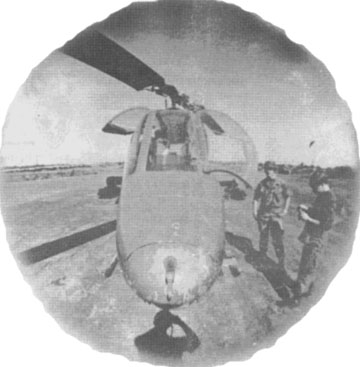 activity
with instructions to "stir things up."
activity
with instructions to "stir things up."
Other allied units encircled the zone to choke off enemy escape routes.
According to 1st Lieutenant James Mange, assistant S-3 operations officer for
the 2nd Brigade, the 1st and 2nd Battalions of the Royal Thai Volunteer Army's
2nd Brigade were to conduct saturation ambushes, looking for any increased enemy
activity.
The Thais brought their own artillery - a composite 105 and 155 Howitzer
battalion - in direct support of the operation.
In the northeast corner of the zone, 18th ARVN Division units (the 2nd of the
43rd and the 2nd of the 48th) began intensified patrolling operations in
preparation for the enemy should he try to infiltrate through their area of
operations.
The 25th Division's 3rd Battalion, 22nd Infantry Regulars with Charlie
Company, 1st Battalion (Mech), 5th Infantry under their operational control,
began increased patrolling operations in the southeast corner.
With all units in position, the operation was kicked off when two 18th ARVN
Division ranger battalions, the 33rd and 51st, began a north to south sweep from
QL1, the highway between Xuan Loc and Long Binh. The next morning, the 30th
ARVN Ranger Battalion was air-inserted into the middle of the area of operations
to complete Task Force 333.
The insertion went off in orderly fashion. The young ARVN rangers lined up
according to chalk loads on the rock-strewn air strip.
The II Field Force choppers were on the ground waiting for the word. When it
finally came, the ARVNs were in their AO within an hour.
According to 2nd Brigade Commander Colonel Joseph R. Ulatoski of Stamford,
Conn., the value of the operation lay in the experience gained from several
allied units operating together in the same area.
Charlie
Triggers
Ambush
CU CHI - DABOOM! A sudden explosion rocket the air.
"Here we go again. Get those 81s (81mm mortars) ready to fire. Second
platoon, mount up' and get set to move out," shouted triple deuce's Captain
James Schmidt, Alfa Company commander.
The enemy had just detonated another one of 2nd Battalion (Mech), Infantry's
mechanical ambushes (claymore mine).
After firing 81mm mortars into the ambush area, the company moved in on
armored personnel carriers to sweep. They found two dead enemy and two AK-47
rifles.
"We have been working an area approximately 14 miles north of here during the
last month and a half," said the San Diego company commander. During this time
we have killed twenty enemy with mechanical ambushes alone."
By studying the enemy's habits and patterns, the unit has been able to
systematically set up mechanical ambushes in areas of suspected enemy movement.
This technique has been mastered by two veteran Triple Deucemen, Sergeant Henry
McDonnell and Sergeant Henry Smith.
"Before we started using mechanicals, the enemy could walk his trails at
night like he was back in Hanoi," said McDonnell of Collbran, Colo. "Now he has
to find new trails and we're forcing him to move during the daylight hours."
Rangers
Thread
Needle
By PFC DAVE COOPER
CU CHI - While on recent operations in the Hobo Woods, a 25th Division Ranger
team threaded the needle with hand grenades, resulting in one enemy killed and
two wounded detainees.
At about dawn on the last day of the three-day operation, the team from F
Company, 75th Rangers, heard several enemy crashing through some nearby bushes.
"The enemy set up a day resting position only about 30 feet away from us,"
stated team leader Sergeant Scott Cook of Grass Valley, Calif. "A few minutes
later one of them got up and started walking down the trail, but we didn't
follow him."
That left the others vulnerable to the Rangers' skills.
Besides the Communist casualties, this action also netted 20 VC ponchos,. one
full AK-54 magazine, a US pistol belt and flashlight, some medical supplies and
clothing.
Page 2 TROPIC LIGHTNING NEWS November 2, 1970
 |
 |
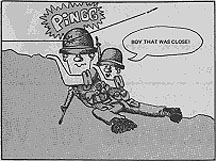 |
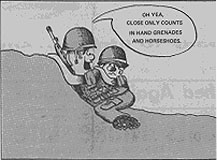 |
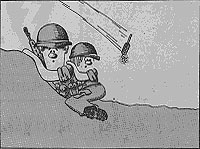 |
| BOY THAT WAS CLOSE! | OH YEA, CLOSE ONLY COUNTS IN HAND GRENADES AND HORESHOES |
|
Division Yearbook For SALE CU CHI - The Tropic Lightning Association announces that orders for the
new Division Yearbook, VIETNAM: 1970, can be made by contacting your Battalion
S-1 or Brigade Headquarters Company. |
Shake and Bake NCOs
A Step Up In Responsibility
By SP4 GARY PETERSON DAU TIENG
"Well, if you ask me `Shake and Bakes' almost run the Army over here."
So said one 25th Division trooper in a recent survey of opinions on
non-commissioned officer schooled sergeants.
An NCO candidate is given 12 weeks of instructional training and, after
graduation, as an E-5 or E-6, eight weeks of on-the-job training with an
Infantry advanced individual training unit. If he is then sent to Vietnam, in
many cases he is immediately put in charge of a squad in the field.
How do these instant leaders shape up to the task? How do they adjust to
leading men in a combat situation, when they're not even sure how they themselves will react
under fire? These and other questions were recently put to several members of
the 2nd Battalion, 14th Infantry Golden Dragons.
Do you think an NCO school sergeant is ready to lead a squad upon arrival in
Vietnam?
Most of the men answered no to this question. Many felt that, while people
differ, for the most part a new sergeant should have time to get to know his men
and vice versa before assuming leadership.
They also stated that the field is such a unique experience that a man should
have time to adjust before taking the responsibility for other peoples lives.
"I feel the new sergeant should have at least a week to adjust," said platoon
leader Sergeant James Wolfe of Madison, Wis., from Alfa Company. "When you first
get out to the field everyone and everything is new. You really have a feeling
of insecurity.
Platoon sergeant, Sergeant Robert Silva of Petaluma, Calif., saw it
differently.
"Yes, I feel he's ready to take a squad upon arrival. He's been trained to
lead at NCO school and has led men in an AIT unit."
What problems do these sergeants face when they first take a squad?
Most said they had never seen any major problems arise. A few said that when
a Specialist 4 had been running their squad, there was some friction between him
and the new sergeant, but nothing serious. Most said that the new NCO fit in
pretty well, and quietly observed how things were run before asserting much
authority.
"When I first took over, I wasn't really squad leader except in name," said
Silva. "I didn't take over for a couple weeks."
Do you think the NCO school program should be continued?
The majority said yes. They stated that men with intelligence and
leadership qualities should receive formal instruction in leadership through
the program.
To Soldiers & Gridders Alike
Teamwork is Way of Life
By PFC MIKE ROBERTS
XUAN LOC - Throughout Basic and AIT. (Advanced Individual Training), the Army
emphasizes teamwork, but for Specialist 4 Dennis Thorell of Loomis, Neb.,
teamwork has been a way of life for a long time.
Thorell, an RTO (radio telephone operator) for Bravo Company, 4th Battalion (Mech),
23rd Infantry, played football for the University of Nebraska before entering
the service. He was a free safety for three years for the "Go Big Red"
Cornhuskers.
"The success of each play in a football game depends on how well each of the
eleven men do their job," said Thorell. "The same goes for squad, platoon, or
company sized operations."
During three years of varsity competition, Thorell played in three major
post-season games. In 1965, he played against the University of Arkansas in the
Cotton Bowl. The next year he played against Alabama in the Orange Bowl and,
during his senior year, Alabama again, this time in the Sugar Bowl.
"There were times against Alabama that I would have liked to call in arty and
gunships," kidded Thorell.
After graduation, Thorell played two years for the Omaha Mustangs, a semi-pro
team in the Continental League. The Mustangs are affiliated with the Kansas City Chiefs.
| TOMAHAWK CORNHUSKER - Specialist 4 Dennis Thorell traded his football helmet for a CVC combat vehicle crewman's helmet. An RTO he now "plays" for the 25th Division's Bravo Company, 4th Battalion (Mech), 23rd Infantry "Tomahawks." He played free safety for the University of Nebraska, "Cornhuskers" in the Big Eight Conference. |
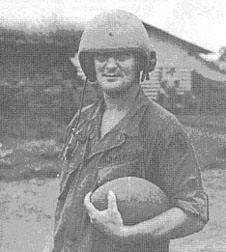 |
The TROPIC LIGHTNING NEWS is an authorized unofficial publication of the 25th Infantry Division. It is an offset publication delivered weekly for all division units in the Republic of Vietnam by the Information Office, 25th Infantry Division, APO San Francisco 96225 (Phone number: Tiger 925 5011/5538). American Forces Press Service and Army News Feature materials are used. Views and opinions expressed are not necessarily those of the Department of the Army. Printed in Tokyo, Japan, by Pacific Stars and Stripes.
MG Edward Bautz, Jr . . . . . Commanding General
MAJ Robert E. Kelso . . . . Information Officer
1LT Martin E. Webb . . . . . Officer-in-Charge
SP4 William M. Lane . . . . . Editor
SP4 Scott Watson . . . . . . . Assistant Editor
SP4 Michael J. Winston . . Production Supervisor
BATTALION CORRESPONDENTS
| SGT Derr Steadman SGT Mike Bailey SGT Bryon Fites SGT Mark Rockney SGT Mike Conroy SGT Daniel House SGT Jack Strickland SGT Dan Davis SGT Bob Lodi SP5 Tom Watson SP5 Doug Sainsbury SP4 Frank Salerno SP4 Tom Benn SP4 Greg Duncan |
Discom 4/23 4/23 2/12 3/4 Cav 4/9 1/27 1/27 1/5 725th 2/77 2/22 7/11 2/27 |
SP4 John Corbin SP4 Rich Erickson SP4 Ed Toulouse SP4 William McGown SP4 James Duran SP4 Kris Peterson SP4 Frank Morris SP4 Phillip Maslin PFC Dan Lowry PFC James Stoup PFC Doc Polls PFC Dan Danley PFC Mike Roberts PFC Richard Haley |
1/5 2/14 2/12 Divarty 3/13 3/22 2/34 2/27 2/27 65th Eng 269th 4/23 4/23 1/8 |
Page 3 TROPIC LIGHTNING NEWS November 2, 1970
IT'S HAPPENING
BEAUTIFUL...A girl with a name like Barsy Cavelty has got to have something.
And she does. She has 3,000 European girls itching to write GIs in Vietnam.
Barsy is from Locarno, Switzerland., and her program began by accident. But now
that it's going, she is eager to continue. Her English isn't perfect, but her
thoughts come through loud and clear in a letter addressed to soldiers of the
25th Division. After outlining the purposes of her thing, she concluded: "This
project, called by my friends 'Operation Barsy, Vietnam' started 30 months ago,
as my address (sic) ended by some misunderstanding by a Pen Pal list of a
military paper there in Vietnam. Since then my Opn has become to be an 'All
Around Year Program' swinging pretty well. It still does-with one hitch-YOU!!
Yes I need quite a lot addresses (sic) from you. Sooo, may I hope to hear from
you and your fellow servicemen in Vietnam? As I said, I hope you won't look all
to straight on my many mistakes in this letter-I'm still learning (Uhh, yay...with
you guys as my teachers. Therefore I can cuss pretty groovy-but writing a
letter in a ladylike style? Oh boy ... its too damn difficult)."
If you'd like to take one of these European lasses off Barsey's hands, send
your address to: Miss Barsey Cavelty, C.P. 101, 6600 Locarno, Switzerland.
WHY IS DEBBIE LAUGHING?...Because her Cu Chi Bunker Bunnies are romping all
over the men of the 125th Signal Battalion. Debbie, Special Services recreation
director, goes into third base standing up as SP4 Mark D. Noyer of the 125th
waits vainly for the throw.
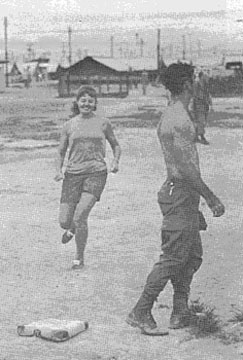 |
IN STORE FOR YOU ... Next time you make it to Cu Chi, walk toward the PX,
turn right at the snack bar, and look for a little red sign that says "Tropic
Lightning Gift Shop." Inside you'll find such treasures as 25th Division letter
openers, beer mugs, wallets, cigarette lighters and division yearbooks. Add a
little Electric Strawberry to your life. Stop by the gift shop.
WE LIED TO YOU ...A couple of weeks ago we announced a contest in the Tropic
Lightning News inviting soldiers to submit answers to the digital question:
"what does the following combination of numbers signify - 29-19-12?" We said
that one entry would be chosen at random from all correct entries and that the
winner would get a 3-day pass to China Beach. Sorry. One winner will not be
going to China Beach. Six winners will. Yes, friends, we picked six names out
of our scrungy bush hat and all will trip north. The luckies are: PFC Donald E.
Bruton, Company C, 125th Signal Battalion; SP4 Franklin Freeman, HHC, 2nd
Battalion, 27th Infantry; PFC Richard Guerard, HHC, 65th Engineer Battalion; SP4
Dean Montour, 66th Infantry Platoon Combat Trackers; PFC David E. Dwelley, 25th
Admin Company and Refugio C. Fonseca, Company D, 725th Maintenance Battalion.
Oh, yes, the answer. The number 29 equals the age of the 25th Division, 19 is
the number of years the division has spent overseas and 12 is the number of
years the division has engaged in active combat. Isn't that interesting."
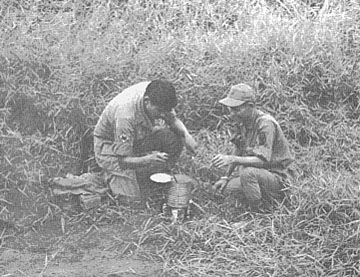 |
THE CHIEF AND THE SCOUT - Specialist 4 Darrell "Chief" Buck Elk and Kit Carson Scout Dang Van Co exchange cooking tips during a chow break 15 miles south' of Xuan Loc (Photo by PFC Mike Roberts) |
The Chief Tracks Charlie
Sioux Brave on the Warpath
By PFC MIKE ROBERTS
XUAN LOC - The Tomahawks of the 4th Battalion (Mech), 23rd Infantry have a
real live tomahawk in their midst.
He is Specialist 4 Darrell Buck Elk of Popular, Mont., a Sioux who uses his
Indian skills to help his buddies in the field.
Volunteer
"Chief," as he is known to his friends, volunteered for the infantry and
Vietnam when he joined the Army. He got his nickname during basic training and
hasn't been able to shake it yet.
"Since I've been in the Army, I've always been called Chief," Buck Elk said.
"I suppose if someone called me Darrell, I probably wouldn't answer."
As a youngster, Chief learned how to track from his father and brother, a
skill he practices even now as an 11-Bush.
Cowboys and Indians
"As a boy, we used to play cowboys and Indians," he said. "And I used to
track the other kids."
Buck Elk noted grimly that "too many guys walk a RIF
(reconnaissance-in-force) like they're back on the block. On dismounted RIFs,
it is very important to avoid making unnecessary noise to remain unnoticed by
the enemy. You just can't drag your feet and still keep noise at a minimum."
Chief said that a good infantryman must be observant and employ the practice
of stepping down with the balls of his feet, instead of his heels.
Cautious and Observant
"If you're cautious and observant," he says, "the chances of making your
presence known to the enemy can be greatly reduced."
During his tour in Vietnam, Chief has found numerous enemy trails and
equipment which other GIs had walked past while on patrol. He also excels in
building waterproof poncho hootches in the monsoon weather and is always willing
to share his knowledge with others.
Learns from Scouts
"I enjoy exchanging ideas with the scouts and working with them. They're
very quick in noticing booby-traps and finding signs of enemy activity. I've
learned a lot from them."
Drawing on traditional Indian skills, Chief even uses his special knowledge
about cooking to enliven C-ration meals. He often can be seen mixing up a
gourmet meal with the scouts by adding rice and wild greens to the Cs.
Destiny
It would seem that Buck Elk was destined for the Army. Before enlisting, he
worked at Tribal Industries at Ft. Peck Reservation in his hometown repairing
Army small arms.
Then, he traded his moccasins for tropical combat boots and his job for an
M-60. And Darrell Buck Elk became a chief.
Sarge Leaves Canada To Join Sam's Army
By SGT ED TOULOUSE
FSB JAMIE - "I am proud to be in the American Army and I am interested in
doing my part here in Vietnam."
So says a Canadian member of the 25th Division's 2nd Battalion, 12th
Infantry.
Canadian Vet
A former citizen of Montreal, and a veteran of six years in the Royal
Canadian Army, Staff Sergeant Joseph G. Goyette left his snowbound home almost
ten years ago to join the US Army.
Now in his second tour with an infantry unit in Vietnam, the French and
English-speaking platoon sergeant had to sacrifice his former Canadian rank of
Sergeant and begin again, as an E-1. But Goyette has no regrets.
Chance to travel
"Being with the US Army has given me the opportunity to travel - something I
have always wanted to do," he explained.
According to Goyette, obvious similarities and marked differences exist
between the two fighting forces. Unlike its US counterpart, the Canadian Army
relies entirely on three or six-year terms of enlistment to meet its less
demanding needs.
No One to Blame
"In Canada, if a man gripes about the army, he has nobody to blame but
himself," said Goyette.
The veteran feels that the introductory training (basic and advanced) in both
forces is quite similar in the sense that discipline is obligatory and physical
endurance demanding. However, Goyette did have one particular problem.
New Language
"I am French but I always thought that I was adequate in English until I
encountered some of the rapid commands given in US training," the sergeant
related. "It was like a new language."
Goyette finds that chow, always of concern among the men of both armies,
remains pretty much the same - there's always plenty of it.
Ironical Twist
Following his first tour in Vietnam, Goyette has since revisited
acquaintances in the Canadian Army and finds a rather ironical twist in their
opinions.
"Many of them have ambitions of coming to Vietnam too. They believe in our
cause."
Page 4 - 5 TROPIC LIGHTNING NEWS November 2, 1970
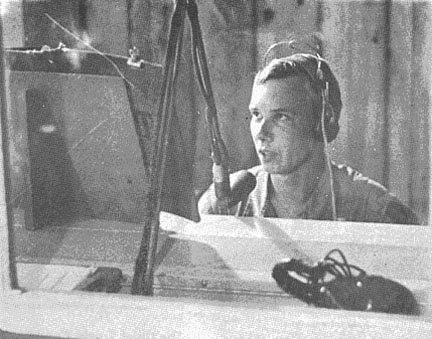 |
| COUNTRY TIME -- Specialist 4 Tim Anderson, alias Tim Stone, of Clarion, Iowa, handles WTLB's early morning Country and Western Show. |
WTLB - On The Air
By SP4 RICH ERICKSON and SGT ED TOULOUSE
DAU TIENG - If stateside radio is what you're looking for, it can be found by
tuning to 107.8 on the FM dial - WTLB (Radio Tropic Lightning Brigade).
The 125th Signal Brigade's new radio station was recently put into operation
here, broadcasting the "NOW" sounds to those in the 1st Brigade area.
It was almost four months ago when three GI's, formerly with WACR (Radio
Blackhorse) at Quan Loi, arrived at the 1st Brigade base camp with five conexes
containing turntables, recording equipment and 5,000 records. Their objective
was to build a radio station.
"It was quite a challenge," explained Specialist 4 Mike Smith of Tulsa,
Okla. "We had to turn the dusty hootch that we found at our disposal, into an
air-conditioned, soundproof, broadcasting studio, which is more of a job than
one might imagine."
Five weeks later, after using such field expedients as claymore wire to hook
up their equipment, and mattresses to insulate the broadcast booths from the
sounds of the base camp, the task was finished.
Special attention was given to "Sinners basement", a music graveyard for the
"moldy oldies" and point of origin for some heavy sounds.
Commercials such as "Fill 'er up with Mobil Gas", and "Hai Karate Self
Defense Lesson 1", with no actual monetary backing, lend authenticity to the
station's "Stateside Radio" slogan.
The station's programming covers a wide range in musical tastes. Through the
sounds of Heavy Rock, Soul and Country & Western, WTLB hopes to simulate the
GI's favorite radio station back in the world.
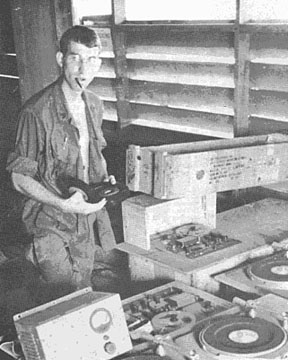 |
MOVING IN - Upon arriving at Dau Tieng, home of the 1st Brigade, the DJ's had
to put in a little off the air time sorting out equipment.
|
|
OFF THE AIR - Records and heavy sounds were preceded by many hours of sawing,
hammering and hard work before WTLB could serve the men of the 1st Brigade.
|
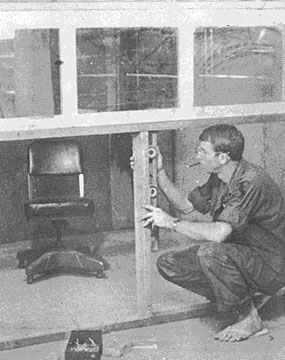 |
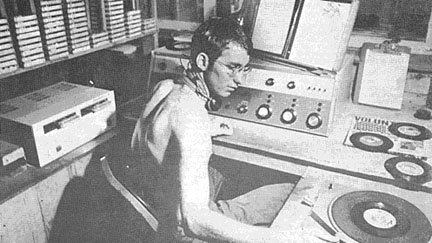 |
ON THE AIR - Specialist 4 Mike Smith, alias Mike Stewart, of Tulsa, Okla.,
cues up another disc for WTLB "Stateside Radio" at Dau Tieng,
|
| CONTROLS - Facing this WTLB DJ is a maze of switches, meters, dials, scripts and turntables--all tuned for the listening pleasure of the men of the 1st Brigade. |
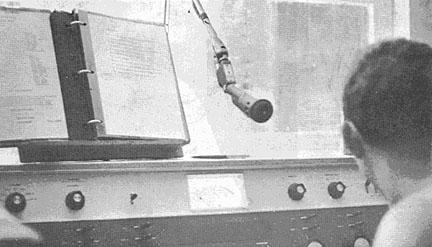 |
Page 6 TROPIC LIGHTNING NEWS November 2, 1970
Hawks Play Games; Train Rooks, Vets
By PFC MIKE ROBERTS
OB LYNCH - War games in a combat zone? Yes, indeed.
By simulating contact with the enemy, members of the 4th Battalion (Mech),
23rd Infantry, proved that war games, even in Vietnam can be beneficial.
The games took place recently in the Tomahawk area of operations of Charlie
Company, south of Xuan Loc.
Smoke grenades were used to signify that the lead armored personnel carrier
had been hit and that the company was taking automatic weapons fire. The
reactions of the men were then observed and follow-up critiques given by
seasoned tomahawk leaders.
For those GIs fresh out of combat AIT (advanced individual training), the
field problem gave them a more definite idea of what to expect when they
encounter the enemy.
"I just got here and now I have a much better idea of what I'm supposed to do
when we make contact," said Private First Class Mike Peck, a rifleman, from
Hamburg, N.Y.
"To learn by doing is very beneficial to new guys like me," commented Private
First Class James Minnic of Brooklyn, Mich.
"We got a chance to correct any mistakes we make," said Specialist 4 Gene
Duggan of Malden, Mass. "We also become aware of-many problems that we didn't
realize existed."
"I'm new to a mechanized unit, and this training gives me a better idea of
how they function."
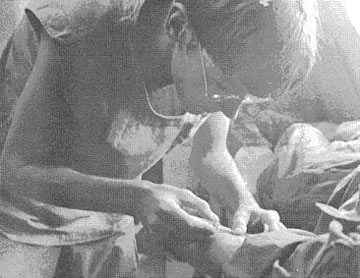 |
CLINICALLY SPECIALIZING - SP5 Jim Yarnall of Chicago prepares to draw blood for a medical test. Yarnell, a clinical specialist, works in 2nd Wolfhound aid-station. (Photo by SP4 Philip Maslin) |
Until It's Time for R & R
Aidmen Are Forgotten Hounds
By SP4 PHILIP MASLIN
CU CHI - If your an infantryman with the 2nd Battalion, 27th Infantry and
you've got a sore foot or you need an armful of shots for that long-awaited R &
R you go to the Wolfhound aid-station.
If you don't need that kind of help, you forget about the station. You
probably don't even know it's around.
Despite their forgotten status, the field medic, clinical specialist and the
battalion medical officer stand ready both in the field and in the rear with a
well-organized system for treatment - and preventive medicine.
The battalion medical officer has many responsibilities in this program.
Since Vietnam has no front line, many Tropic Lightning units do not require
doctors at their aid-stations.
This releases the doctors from administrative duties which can be adequately
handled by a junior officer.
"Our responsibilities range from sanitation to preliminary treatment of
injuries, and from malaria control to aiding the pacification program," said 1st
Lieutenant Don Glover of Salt Lake City.
"A medical officer must meet all battalion dustoffs, make courtesy calls at
the hospital, handle all official medical transcripts of battalion personnel,
brief the commanding officer and make recommendations of health and welfare of
the battalion.
"We have had no malaria cases or other serious diseases for the last four
months which, speaks well for our preventive program."
Scout
Receives
Award
By SGT. MIKE DUNNING
CU CHI - As a Kit Carson Scout received a Silver Star for gallantry here
recently, two young Americans of his 25th Division unit looked on with special
interest - he had risked his life to save theirs.
Kit Carson Scout Nguyen Tong Hieu was a member of a night patrol of B Troop,
3rd Squadron, 4th Cavalry, moving into the Boi Loi Woods when he detected some
slight movement off to his left.
Suddenly Hieu saw a hand grenade fall in front of two of his GI buddies.
Reacting quickly, he pulled the two men down and jumped in front of them,
shielding their bodies from the grenade blast.
Hieu suffered serious wounds on his arms, back and legs as a result.
In connection with that operation, the Vietnamese hero was awarded the Silver
Star Medal for conspicuous gallantry in action.
Ask SGT Certain
DEAR SARGE: I went to pick up my laundry at the PX facility yesterday only to
discover that it was closed. The Army has terminated its contract. I know all
about Vietnamization, but are we really going to have to do all the laundry
while the ARVNs fight all the war? I don't DEROS until June, 1971, and that's a
long time to wear one set of fatigues.
Pvt. M.E. Webb
DEAR MEW: You're right.
DEAR OL' SARGE: Is there a MACV reg against our swimming pool at Waikiki East
being open more than two days each month? I have been stationed here for 10
months and I swear the pool hasn't been open more than a dozen times.
PVT Mike Nelson
DEAR OZZIE: We directed your complaint to the pool NCO, SGT Leif Rafft, and he
said the problem was due to a lack of competent life guards. Of course, he did
mention that the large crater in the pool's bottom was also a factor.
DEAR SGT CERTAIN: Yesterday, my first sergeant assigned me to sandbag detail.
Sarge, I know how important sand bags are to the Army but, well, I was not meant
for such work. I have a masters degree in wax carving, I have toured the finest
art galleries of Europe and I have very sensitive cuticles. I was a flute
player in a rock band before being drafted and to use my delicate fingers for
filling sandbags would be disastrous. I wrote my mother a long; sad letter
about it. She will understand. Why can't the Army be more like my mother.
SP5 H.H.
DEAR DOUBLE H: What do you mean? I've heard many soldiers refer to the Army as
a mother.
| GIVE A LITTLE - Miss Gayle Hunnicutt, like all young ladies, is expecting gifts for Christmas from her young men. Don't disappoint her or them. Mail early. (Photo by SP4 Howard Lavick) |  |
Page 7 TROPIC LIGHTNING NEWS November 2, 1970
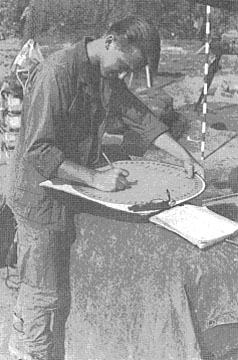 |
PRE-PLOTTING - SGT John Nowak marks the position of a proposed night ambush on his plotting board. |
| HANG IT - SP4 Edward McKinney, an assistant gunner, prepares to place a round in the tube as his gunner makes a last minute check for accuracy. |
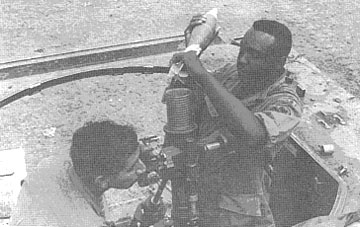 |
Providing Fire Support
Mortarmen A Moment Away
Story and Photos by SP4 DENNIS LEBLANC
CU CHI - With loud cries of, "Deflection! Elevation! Hang It!", the Triple
Deuce 81mm mortar platoons go into action.
Outside of the mortarmen, the above terms are not too familiar to the men of
the 2nd Battalion (Mech), 22nd Infantry. However, every one of them has on some
occasion used the supporting fire of the mortar platoons.
Each company has its own mortar platoon under the direct control of the
company commander. The mortars are either with the company or within range of
company elements so that they can provide direct fire support at a moments
notice.
"Our principle job is to provide close perimeter defense at the night
defensive position," said Sergeant William Cooper, a Bravo Company mortarman,
from Chelan, Wash.
"We are also the primary source of illumination and fire support for the
company on daylight RIFs (reconnaissance-in-force) and night ambush patrols."
The average mechanized mortar platoon has four tracks - three gun tracks and
one FDC (forward direction control) track.
Each gun track has one 81mm mortar mounted on a rotating base-plate which
allows the gun to fire in all directions. Using three basic rounds, white
phosphorus, illumination and high explosives, the mortarmen can effectively
place rounds within 75 meters of the target and in excess of 4,500 meters down
range. With each gun track carrying a basic load of 120-130 rounds, the mortar
platoon adds greatly to the company's firepower.
When the Tropic Lightning mortarmen are not firing in direct support of the
company during contact, they carry out other important fire missions.
"Many times we fire into an area where there are suspected enemy before the
line elements go in," said Specialist 4 Edward McKinney, a Bravo Company mortar
squad leader from Kennett, Mo. "At other times, as the company moves into its
night defensive position, we fire at suspected, enemy avenues of approach and
pre-plot distances and directions to various point type targets. This enables
us to put out counter mortar fire much quicker if we make contact during the
night."
The mortarmen, as with most support elements, take a little good-natured
ribbing. Their buddies on line like to refer to them as the 81 "Mickey Mouse
Mortarmen" or the "Mouseketeers"
The mortarmen say this is not quite correct. It should be the 81 "Mighty
Mouse Mortarmen" or the "Mini-Maulers".
When the mortarmen are unable to convince their friends they just yell,
"short round" and that ends the conversation right there. For the more
persistent, the mortarmen have their chief computer walk over scratching his
head and ask, "Which way did it go?" That one never fails!
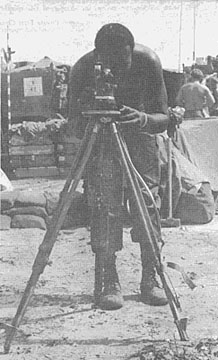 |
LAYING IN - SP4 Tony Davis, a mortarman, makes minor adjustments in the alignment of his aiming circle. |
| ALIGNING THY GUN - SP4 Victor Vecera, Bravo Company gunner, peers through sight as he aligns his gun with an aiming stake. This will insure accurate indirect firing. |
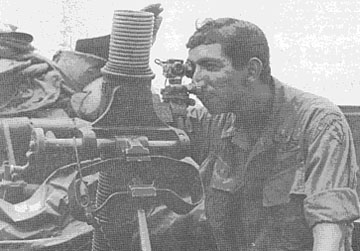 |
Page 8 TROPIC LIGHTNING NEWS November 2, 1970
A Look at the Eyes
Manchus Give New Outlook
By SP4 JOHN M. STIDHAM
CU CHI - In September, the 25th Division's 4th Battalion, 9th Infantry's
MEDCAP team initiated a program of eye examinations with the citizens of Binh-Duong
Province. This newly established program is believed to be the first of its
kind.
The Manchu medics, along with 1st Lieutenant James Smith, the civil affairs
officer, and bilingual Sergeant Vince Fenequito, the civil affairs NCO, from
Tucson, Ariz., have been examining more than 150 school children a day.
At present, all of the children at the Binh-My school have been examined,
along with school-aged children throughout the province.
The students are examined for visual acuity, eye injuries, cataracts,
infections and tropias, which is a defect in the muscular structure surrounding
the eye. Of those examined so far, said Specialist 5 John Stewart, a medic from
Carrollston, Ga., 15 per cent have been found to have eye problems needing
treatment.
These patients are taken to the 25th Medical Optical Clinic where they
undergo more extensive tests. If these tests reveal a need for surgery for
cataracts or trophia conditions, the patient is referred to the 12th Evacuation
Hospital.
If glasses are the solution, the child is transported by the Manchus to 3rd
Field Hospital in Tan Son Nhut to be fitted for a new outlook on life.
While the eye examinations are being conducted at the Binh-My school, Stewart
performs a little doctoring.
He dispenses cough medicine, hydrogen peroxide, bacitracin, which is a
disinfectant, eye ointments and other hard-to-get antibiotics.
According to Smith, who lives in Hobbs, N.M., "the main targets of the
Medical Civic Actions Program are Vietnamese children."
Throuh their friends in Binh-My and the five nurses at the Phu Hoa
Dispensary, the MEDCAP team has been able to find and coordinate the surgical
treatment of many young Vietnamese, said Smith.
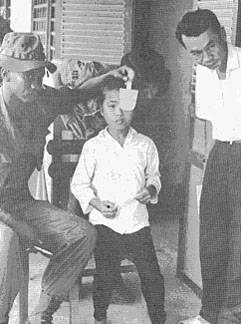 |
EYE EXAMINATION - First Lieutenant James Smith of Hobbs, N.M., presently serving with 4th Battalion, 9th Infantry examines one of many children from Binh-Duong Province. |
Regulars Kill Three During Recent RIF
By SP4 KRIS PETERSEN
OB LYNCH - "Regulars" of the 3rd Battalion, 22nd Infantry, combining
alertness and quick reactions, killed three enemy recently while on an operation
near here.
While on a RIF (reconnaissance-in-force), a recon platoon of Echo Company
found a likely spot for a night ambush position. A squad was sent out to set up
mechanical ambushes near the main site, then everyone dug in and waited.
"We figured the trail as a frequently-traveled supply route for Charlie's
larger size forces," commented Sergeant Herman William of Rexburg, Idaho.
Early the next morning, the squad went back out to disarm the mechanicals.
Suddenly a thunderous explosion rocked the air. An unsuspecting NVA, as it
turned out, had tripped one of the devices.
"I quickly assembled my men and moved forward to reinforce the smaller
squad," said 1st Lieutenant Richard Simmons of Chico, Calif.. "After a few
minutes we began to sweep the area."
As they were making the sweep, the sharp-eyed GIs spotted another Communist
moving toward them.
"We heard the pin of a grenade pop," said Private First Class William Cook of
Statesville, N.C. "We all hit the ground and opened up."
The NVA never had time to get rid of the grenade as he was cut down quickly
by the Regulars' fire. The third Communist was seen while sweeping further down
the trail."
"We saw his hand reach out for his AK," said Private First Class James Sheets
of Eldon, Iowa. "But like the dude with the frag (grenade), he didn't get to
use his weapon either."
According to Simmons, the three were probably an advance team checking the
area for a larger enemy force.
"All I can say is that we must have rolled out on the right side of our
poncho liners that morning," quipped Private First Class Phil Morris of Winston
Salem, N.C.
Mobile Checkpoints Add Security
By SGT BOB LODI
CAM TAM - To a GI, an ID check usually accompanies the purchase of a money
order at the APO. But, recently, the men of the 25th Division's 1st Battalion (Mech),
5th Infantry turned the tables and did the asking, as an ID check was made on
the rubber workers near Cam Tam village.
The check was part of population, resource and traffic control program and
was coordinated with the National Police of Xuan Loc District.
In regards the program Bobcat Battalion Commander Lieutenant Colonel Oliver
Combs, Jr. said, "We can, through pacification, counteract VC tactics by
securing the villages and promoting the concept of domestic growth which seeks
to liberate the people from VC control."
The mech unit started out early in the morning escorting the rubber workers
from a National Police checkpoint to the rubber plantations. The APCs have been
called many names, but Mobile Checkpoints was a new one for even the oldest
hands.
Combs felt that the program is an effective method of stifling enemy resupply
lines by weeding out the VC sympathizers among the rubber workers.
Many of the Bobcats felt sorry for the innocent Vietnamese who were asked
many times to produce an ID.
Priest Delivers Love
And Receives Smiles
By 1LT ED HERRON
XUAN LOC - Father Jerome Taddy, a captain of the Army and a chaplain of the
25th Division, feels it is better to give than to receive.
And so, he has given his heart to 300 youngsters at Ky Nhi Vien Orphanage
north of this 2nd Brigade Camp.
Taddy of Green Bay, Wis., along with his assistant, Specialist 4 Dick
Anderson of Solway, Minn., have made numerous visits to the orphanage each time
bringing food, candy and soap for the children.
The kids have learned to recognize the chaplain and his assistant as bearers
of gifts and squeals of delight have become common whenever they arrive at the
orphanage.
As Taddy and Anderson pass out candy and other items, the children sing
Vietnamese songs for the Americans. Each youngster's eyes brighten up when he
receives his share of goodies.
The nuns at the Roman Catholic Orphanage are very appreciative of the GIs'
efforts and provide cold drinks and fruit for Taddy and the others that visit
the orphanage.
The nuns do not speak English, so Taddy is working with the Warrior brigade's
S-5 Captain Mark W. Wong of Boston in setting up English classes for them.
Taddy enjoys helping the children. As Anderson says, "Father will give away
anything if he thinks someone needs it. I think he'd give away our jeep if I'd
let him."
| CANDY AND KIDS - A Roman Catholic nun watches as Specialist 4 Dick Anderson, 2nd Brigade chaplain's assistant from Solway, Minn., passes out candy to the children of an orphanage north of Xuan Loc. |
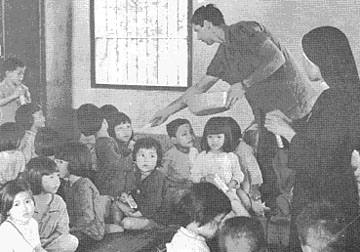 |
Thanks to:
John Nowak, 2nd Bn. (Mech), 22nd Inf.,
for sharing this issue,
Kirk Ramsey, 2nd Bn., 14th Inf. for creating this page.
This page last modified
04-04-2009
©2009 25th Infantry Division Association. All rights reserved.